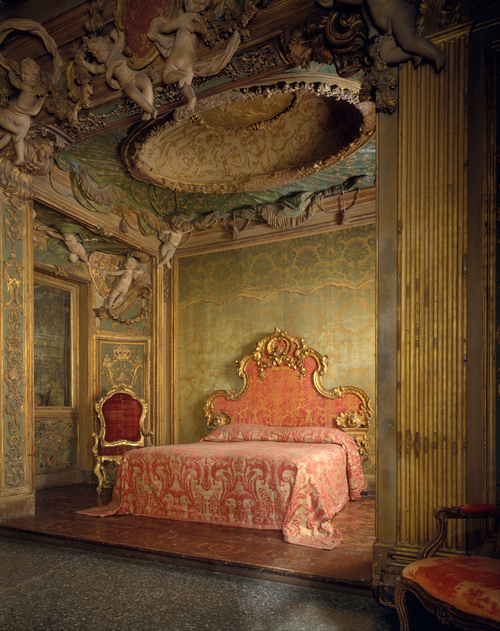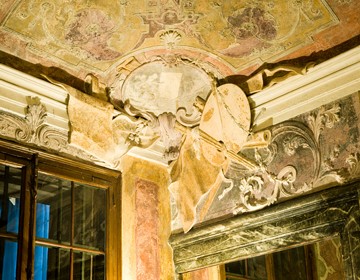Venice's Ca Sagredo is a precious gem if there was ever was one. It dates to the 15th century and was the home of the Morosini family for over 100 years. The Morosinis were dedicated patrons of the arts, and their palace fully reflected their tastes and their wealth. In 1661 the palace was acquired by the noble Venetian Sagredo family, whose ancestry is documented back to the 11th century. Nicolo Sagredo is credited as the first family member to bring art to the palace. Modifications were made to convert the palace into the family’s private art gallery. Zaccaria Sagredo acquired over 800 paintings. The collection was considered one of the greatest in Europe.
In the 18th century, the Sagredos continued to make artistic improvements to the palace. Once you step inside, you know you are somewhere special. The grand marble staircase, commissioned by Nicola Sagredo, was designed by Venetian architect Andrea Tirali in the 1730s. The prominent marble cherubs at the base of the stair were created by sculptor Francesco Bertos, and the painted ceiling is by Pietro Longhi.
This Venice “museum” is now the exclusive luxury boutique hotel Ca Sagredo. There are 42 rooms and suites, truly steeped in history while taking Venetian luxury to a new level.
Enjoy this Venetian Baroque piece while you visit.
Leaning majestically on the banks of the Grand Canal, between Ca’ D’Oro and the Rialto Bridge, the 15th century Palace has been declared a National Monument and still preserves the untouched beauty of an ancient noble Residence
The grand marble staircase, commissioned by Nicola Sagredo, was designed by Venetian architect Andrea Tirali in the 1730s.
The prominent marble cherubs at the base of the stair were created by sculptor Francesco Bertos, and the painted ceiling is by Pietro Longhi.
In the golden and exquisite Music Ballroom, numerous frescoes attributed to Gaspare Diziani completely cover the walls and ceiling.Splendid chandeliers in gold leaf hang from the ceiling, and the floor is embellished with the coat of arms of the Sagredo family.
The frescos on one wall act as a camouflage for a door to the secret passage which once led to the “Casino Sagredo”. This passageway was used by mistresses during balls to discretely make their way to the master’s alcove.
Ceiling of the Music/Ballroom
The Portego (Central Hall) is a broad salon which runs along the whole first floor connecting the façade to the back of the building.
Most of the Palazzo’s main halls –the Library, the Sala di Sebastiano Ricci, the Sala dei Disegni- on the noble floor surround it. During the height of it splendour, numerous paintings hung among the stucco work: in 1738 they were 105, in four rows. Between 1774 and 1780 these paintings were sold and replaced with large canvases by Andrea Urbani, still hanging, which depict landscapes with ruins and hunting scenes.
The other end of The Portego
Adjacent to the Portego, the Sala Amigoni is the connection area with the other function rooms of the noble floor.
This fabulous bedroom was removed from the Sagredo Palace and is preserved in the Metropolitan Museum of Art. In design and workmanship, this bedroom, consisting of an antechamber with a bed alcove, is one of the finest of its period. The decoration is in stucco and carved wood.
The brilliant wooden frame of the bed evokes the high point of Rococo furniture, with sinuous lines, scrolling curves, and floral motifs in plenty. The crown of the dome, fluted Corinthian columns, frame of the bed and chair, and brocatelle fabric glisten with hints of gold. The bed alcove has its original marquetry floor. The stuccowork was probably done by Abondio Statio and Carpoforo Mazetti.
After waking up in the Sagredo Palace, one would have left the alcove where the bed sits, and entered an antichamber to be greeted by another heavenly vision: Dawn Triumphant Over Night.
This Suite called the Stucco Suite is one of the most emblematic of the entire building: the ceiling features magisterial decoration by two famous artists from Lugano who worked for the Republic of Venice in the early eighteenth century: Abbondio Stazio and Carpoforo Mazzetti, known as Tecalla.the exceptional quality of the depictions, ceiling paintings and friezes – birds, exotic animals and various mythological characters – all in different relief and painted in a variety of delicate hues, almost like pastel: without doubt the most remarkable example of the artists’ work in Venice.
These rooms were formerly the private apartments of Count Sagredo, and were connected to the main building through secret doors.
Decorated with stucco works and bas relieves depicting birds, exotic animals, symbols of the arts and trophies. In one of the rooms the emblems of painting, sculpture, music and architecture are represented on the four upper corners, and three refined landscapes are on the ceiling.
The bedroom area of the Stucco Suite
The following images are some of the hotel's hotel’s 42 magnificently appointed rooms and suites
At the Sagredo one can step back in time to discover and live the Venetian elegance and old world charm.
Click here to see the previous post!
This blog post was published by
Lisa Farmer







.jpg)


.jpg)


.jpg)









.jpg)









